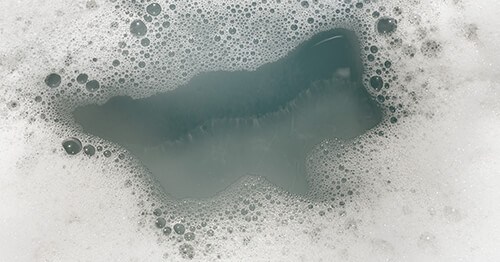Examining the Causes of Sewage Backflow in the Bathtub
Examining the Causes of Sewage Backflow in the Bathtub
Blog Article
Just how do you feel in relation to Why is There Sewage Coming Up Through the Bathtub?

Sewer back-up in the bath tub can be a distressing and unsanitary trouble for any house owner. Not only is it bothersome, yet it additionally postures significant health and wellness threats and indicates underlying problems with the plumbing system. Comprehending why sewer is coming up through the bath tub is essential for taking ideal action to resolve the problem efficiently.
Intro to the Concern
Common Factors for Sewage Backup
Obstructions in the Sewage System Line
Among one of the most usual reasons for sewer backup is a clog in the sewage system line. This can happen due to the accumulation of particles, grease, or foreign items in the pipelines, protecting against proper circulation and triggering sewer to back up right into your tub.
Tree Origin Breach
Tree origins seeking wetness and nutrients can penetrate sewer lines via tiny fractures or joints. Over time, these origins can grow and increase, causing significant damages to the pipes and resulting in sewer backup issues.
Comprehending the Problem
When sewage starts backing up into the tub, it's a clear sign of an issue with the water drainage system. The wastewater that needs to be streaming far from your home is instead discovering its back into your space, which can lead to considerable damages and carcinogen.
Potential Reasons
Numerous aspects can contribute to sewer backup in the tub. From obstructions in the sewage system line to problems with the plumbing framework, identifying the root cause is necessary for discovering a service.
Aging Facilities
Older homes may have dated plumbing systems that are a lot more at risk to corrosion, fractures, and deterioration. As pipelines age, they become extra susceptible to leakages and obstructions, increasing the likelihood of sewer backup cases.
Heavy Rainfall or Flooding
During durations of heavy rainfall or flooding, the sewer system may come to be overwhelmed with excess water, triggering back-ups and overflows. This can lead to sewer backing up right into bath tubs and various other fixtures inside the home.
Signs of Sewer Backup
Foul Odors
Unpleasant smells originating from drains pipes or fixtures, particularly in the shower room, may suggest sewage back-up concerns. These smells are usually solid and consistent, signaling a trouble that requires prompt attention.
Slow Draining Fixtures
Tubs, sinks, and toilets that drain pipes slowly or otherwise whatsoever could be experiencing sewer backup. If several fixtures are impacted concurrently, it's most likely that the problem stems from a typical factor, such as the primary sewage system line.
Gurgling Sounds
Weird gurgling or gurgling noises originating from drains when water is running elsewhere in your home are a sign of air trapped in the plumbing system. This air accumulation can arise from sewage back-up and ought to be checked out quickly.
Health Threats Associated with Sewage Back-up
Contamination of Water System
Sewage back-up can contaminate the water in your house, posturing a significant health danger to you and your family. Exposure to infected water can lead to stomach issues, skin infections, and various other diseases.
Mold and mildew Growth
Moisture from sewer back-up can develop suitable conditions for mold growth in your home. Mold spores can intensify breathing problems and trigger allergic reactions in delicate people, making punctual clean-up essential.
Spread of Disease
Sewer contains dangerous microorganisms, viruses, and bloodsuckers that can create a series of illness, consisting of liver disease, cholera, and gastroenteritis. Entering contact with sewage or contaminated surfaces places you in jeopardy of infection.
Tidying up After Sewage Backup
Sanitation Procedures
Extensively decontaminate and disinfect impacted locations after sewage back-up to get rid of harmful germs and protect against mold growth. Use appropriate cleaning products and protective equipment to guarantee safe and efficient cleaning.
Restoration of Influenced Locations
Fix any kind of damage to floor covering, wall surfaces, or components caused by sewage back-up. Relying on the extent of the damage, you may need to change carpeting, drywall, or various other materials to restore your home to its pre-loss condition.
Immediate Actions to Take
Shutting Off Supply Of Water
In case of sewage back-up, it's essential to shut off the water system to prevent more contamination and damages. Locate the primary water shutoff valve in your home and closed it off till the issue can be settled.
Speaking To a Specialist Plumber
Taking care of sewage backup is not a DIY task. Get in touch with a qualified plumber with experience in dealing with sewage-related concerns to evaluate the scenario and do needed fixings or cleanings.
Preventing Contact with Contaminated Water
Till the sewage backup is fixed, avoid contact with polluted water to stop the spread of bacteria and pathogens. Use safety gear if you must be in the damaged location and clean your hands extensively later.
Preventive Measures
Normal Maintenance of Sewer Lines
Schedule normal assessments and upkeep of your sewer lines to determine and address potential problems prior to they escalate right into significant issues. This can include cleaning debris, evaluating for tree root breach, and fixing any kind of damaged pipelines.
Setting Up Bayou Shutoffs
Think about setting up backwater shutoffs in your plumbing system to prevent sewer from receding into your home throughout durations of heavy rainfall or flooding. These valves automatically close when water starts backing up, protecting your building from contamination.
Appropriate Disposal of Household Waste
Avoid flushing anything other than bathroom tissue and human waste down the commode to avoid clogs and clogs in the sewage system line. Dispose of grease, oil, and other family chemicals appropriately to reduce the risk of plumbing issues.
Why Is Water Backing Up in My Bathtub When I Flush My Toilet?
What to do about a sewer line clog
First, don’t bother with plunging. No amount of plunging will dislodge the clog in a sewer line. The clog is too far away. Plungers are for clogs in the toilet itself, not the sewer line. Plus, the most likely causes of a sewer clog are:
Tree roots Flushed toys or feminine products Grease buildup Those items don’t move easily. And in the case of tree roots, the roots need to be cut out of the pipe and the pipe will need to be repaired.
You’ll need a closet auger. A closet auger is a type of plumber’s snake with a protective cover to keep from scratching the delicate porcelain toilet. If the clog is further down, you may need to remove the toilet or use one of your cleanouts to get to the clog.
We also recommend doing a video inspection of the drain to ensure that the cause of the clog has been completely removed. Otherwise, you could have the same problem again in a few days or weeks.
https://mspplumbingheatingair.com/blog/why-is-water-backing-up-in-my-bathtub-when-i-flush-my-toilet

Hopefully you enjoyed reading our part about What To Do If Sewage Starts Backing Up Into the Shower. Thanks a lot for taking a few minutes to read through our article post. Sharing is nice. Helping people is fun. I am grateful for your time. Return soon.
Call Today
Report this page